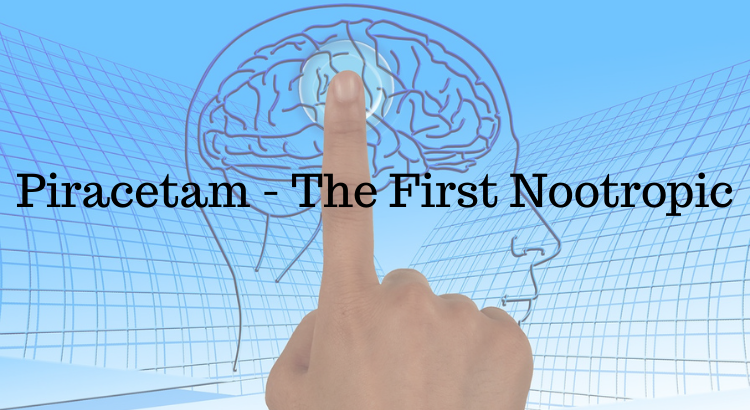Piracetam – The First Nootropic

It’s hard to have a conversation about nootropics without at least mentioning piracetam. After all, it was the creation of piracetam that inspired the creation of the word nootropic.
Piracetam is a safe and effective nootropic that has been around for a long time. And, unlike many newer nootropics, it has decades of research behind it to support its safety and efficacy.
The nootropic benefits of piracetam can include increased focus, improved mood, and reduced anxiety. And, when taken daily, it can improve blood clotting, reduce the symptoms of depression and anxiety, and treat breath-holding spells in affected individuals.
We’re gonna look at the benefits, side effects, dosage, and history of this fascinating substance. But first, let’s look at what exactly piracetam is.
What Is Piracetam?
Piracetam is a nootropic drug that is a member of the racetam family. These include a number of chemically-similar drugs that all have nootropic benefits.
This interesting substance was first created in 1964 by the Romanian chemist and psychologist, Corneliu E. Giurgea. He was the first person to use the term “nootropic,” after noticing piracetam’s apparent cognition-enhancing properties. This makes piracetam the first nootropic.
Piracetam (also known as pyracetam, pyrrolidone acetamide, 2-Oxo-1-pyrrolidine, Memotropril, and Nootropil) is chemically-similar to GABA. Its chemical name is 2-oxo-pyrrolidine acetamide. It has not been approved by the Food and Drug Administration (FDA) to treat any medical conditions. Because of this, in the United States it is technically illegal to sell as a dietary supplement. However, it is legal to sell for other purposes. And it’s legal to buy and possess.

In other parts of the world, piracetam is used as a prescription medication to treat a number of conditions. It is used in much of Europe, Russia, South America, and other parts of the world. It is commonly sold under the brand name Nootropil.
Like all drugs that affect the brain, it is not completely understood how piracetam works. It affects neuronal, vascular, and cognitive function without acting as a stimulant or a sedative. Piracetam is a positive allosteric modulator of AMPA receptors.
Piracetam also improves the function of the neurotransmitter acetylcholine. This is a neurotransmitter that is known to play a role in memory and learning, among other things. Although piracetam is chemically similar to GABA, it does not seem to affect GABA metabolism or GABA receptors.
Nootropic Benefits of Piracetam
Piracetam is purported to have a number of nootropic benefits. Several studies have shown that it can increase learning and memory, while improving mood, and reducing anxiety.
One study showed that piracetam was able to improve memory and learning after daily administration for 2 weeks. No improvement was noted until the 2-week mark.
Another large, meta-analysis showed that piracetam has a measurable effect on learning and memory, especially in people with cognitive impairment. A meta-analysis is when you take a number of previous studies, and analyze the findings of all of them together.
Piracetam is also reported to improve the symptoms of anxiety and depression. There are countless case reports of this around the internet. However, more studies need to be done to determine just how effective it is.
One study done in people with cerebrovascular disorders showed that piracetam improved mood and reduced anxiety. This effect has not been studied in healthy adults yet, though.
Here are some of the benefits that people are reporting from piracetam:
- Improved Learning
- Memory Enhancement
- Greater Focus
- Improved Mood
- Reduced Anxiety
- Increased Sensory Perception
- Increased Motivation
Piracetam Side Effects
Piracetam has been found to be very well-tolerated. Side effects are rare, and when they do happen, are easily reversible by simply discontinuing supplementation.
The side effects that are occasionally reported include excitability, anxiety, insomnia, irritability, headache, agitation, tremor, and hyperkinesia. These have all been reported in studies done on unhealthy and elderly populations.
Some of the potential side-effects of piracetam can be eliminated by taking it with a choline source, like Alpha-GPC or CDP-Choline. There is a lot of anecdotal evidence to suggest that taking a choline source with piracetam will increase its effectiveness and reduce unwanted side-effects.
Piracetam Dosage
The standard dosage of piracetam for adults is between 1,200-4,800 milligrams (mg) a day. This should be taken in divided doses, split throughout the day. Most users report good results by splitting it between 2 or 3 doses, spaced evenly throughout the day.

Taking a choline source with piracetam is reported to increase its effectiveness and reduce unwanted side effects. Choline supplements increase levels of the neurotransmitter acetylcholine, which is one of the brain chemicals that piracetam works on.
The two most commonly used choline supplements are Alpha-GPC and CDP-Choline. They are very similar, and both compliment piracetam nicely.
Piracetam can be taken with or without food. It is probably absorbed better when taken on an empty stomach. However, if you experience nausea, vomiting, or upset stomach, you should take piracetam with food.
And, as always, we advise you consult with a licensed medical professional before starting or stopping any drug, supplement, herb, plant, or anything else. You don’t necessarily have to listen to them… Just consult with them.